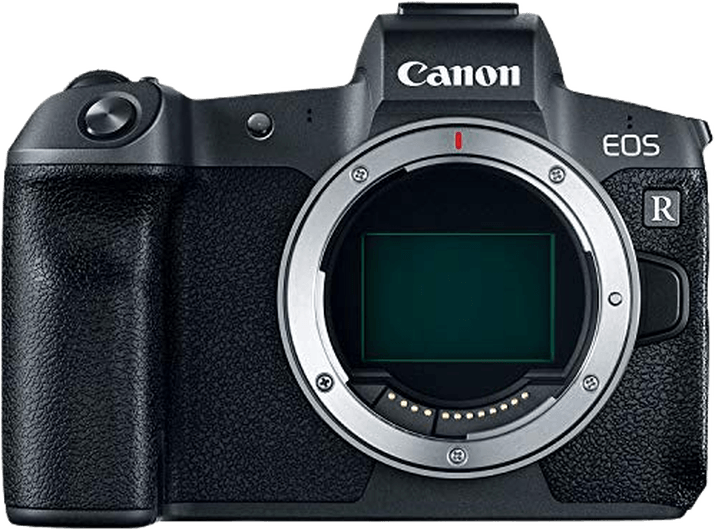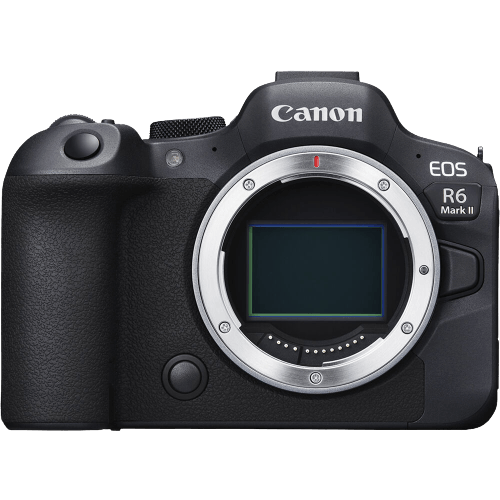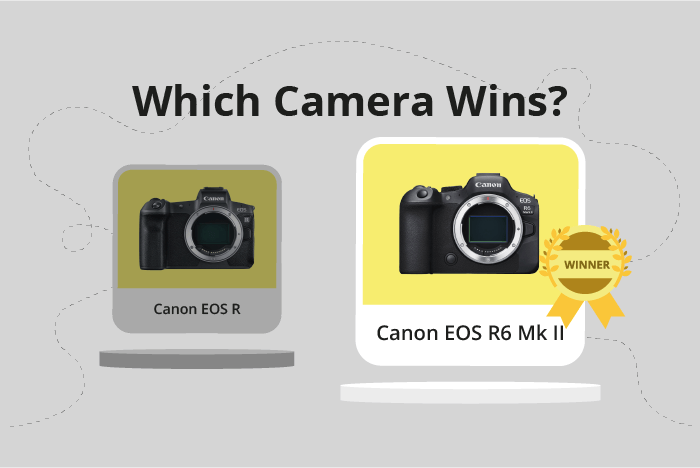Canon EOS R vs EOS R6 Mark II Comparison
Canon EOS R

Canon EOS R6 Mark II

The Canon EOS R6 Mark II comes out ahead with a score of 78/100, while the Canon EOS R trails slightly with a score of 74/100. Both cameras are mirrorless and share some similarities, such as their announcement and release years, with the EOS R in 2018 and the EOS R6 Mark II in 2022. Size-wise, they are quite close, with the EOS R measuring 136 x 98 x 84mm and the EOS R6 Mark II at 138.4 × 98.4 × 88.4mm.
The EOS R6 Mark II offers advantages with its higher score, despite being slightly heavier at 588g compared to the EOS R’s weight of 485g. This difference may indicate better performance and features in the newer model. On the other hand, the EOS R has a lower launch price of $2300, while the EOS R6 Mark II is priced at $2499, making the EOS R more budget-friendly.
Taking all these points into account, the Canon EOS R6 Mark II emerges as the winner due to its superior score, suggesting improved features and performance. However, the Canon EOS R remains a viable option for those seeking a more affordable camera.
Canon EOS R vs EOS R6 Mark II Overview and Optics
The Canon EOS R6 Mark II takes the lead in optics with a score of 83/100, while the Canon EOS R trails behind with a score of 73/100. Both cameras share several specifications, including a CMOS sensor, Full Frame sensor size, and the Canon RF lens mount. However, there are differences that set these two models apart, making one superior to the other in specific aspects.
The Canon EOS R6 Mark II excels due to its faster shooting speed of 40, compared to the Canon EOS R’s shooting speed of 8. The R6 Mark II also features a more advanced Digic X processor, which contributes to better image processing performance. Additionally, the R6 Mark II has a higher DXOMARK score for the sensor at 91, compared to the EOS R’s score of 89. These factors make the R6 Mark II a better option for those seeking faster performance and improved image quality. Furthermore, the R6 Mark II comes with image stabilization, providing an advantage for photographers who require steadier shots.
On the other hand, the Canon EOS R boasts a higher megapixel count of 30.3, compared to the R6 Mark II’s 24 megapixels. This factor allows the EOS R to capture more detailed images, making it a better choice for photographers who prioritize high-resolution photography.
Taking these aspects into account, the Canon EOS R6 Mark II is the better choice for photographers in need of faster performance, better image processing, and image stabilization. However, the Canon EOS R remains a strong contender for those who prioritize capturing high-resolution images.
Canon EOS R vs EOS R6 Mark II Video Performance
The Canon EOS R6 Mark II outperforms the Canon EOS R in video capabilities, scoring 83/100 compared to the EOS R’s 70/100. Both cameras share some common specifications, such as 4K max video resolution and dimensions of 3840 x 2160. Additionally, both cameras have built-in time-lapse functionality.
The EOS R6 Mark II excels in its higher max video frame rate of 60fps, double the EOS R’s 30fps. This difference allows the EOS R6 Mark II to capture smoother and more detailed videos, especially in fast-moving scenes or for slow-motion effects. The higher frame rate gives the EOS R6 Mark II a clear advantage over the EOS R in terms of video performance.
On the other hand, the EOS R does not offer any significant advantages in video capabilities compared to the EOS R6 Mark II. Both cameras have the same max video resolution and dimensions, but the EOS R falls short in the max video frame rate category.
Taking these factors into account, the Canon EOS R6 Mark II proves to be the superior camera for video capabilities. Its higher video score reflects its better performance, mainly due to the doubled max video frame rate. The EOS R, while still offering 4K resolution and time-lapse functionality, does not match the EOS R6 Mark II’s video performance. For those prioritizing video capabilities in their camera choice, the Canon EOS R6 Mark II is the clear winner.
Canon EOS R vs EOS R6 Mark II Features and Benefits
The Canon EOS R triumphs over the Canon EOS R6 Mark II with a feature score of 87/100 compared to 72/100. Both cameras share several specifications, including a touchscreen, flip screen, WIFI, and Bluetooth capabilities. However, the Canon EOS R outperforms the R6 Mark II in certain aspects, while the latter has its own advantages.
The Canon EOS R has a larger screen size of 3.2 inches and a higher screen resolution of 2,100,000 dots, providing a better display and user experience. In contrast, the R6 Mark II has a smaller 3-inch screen with a lower resolution of 1,620,000 dots. The EOS R’s superior screen size and resolution offer enhanced image preview and easier navigation through settings.
On the other hand, the Canon EOS R6 Mark II features GPS functionality, which the EOS R lacks. This provides the advantage of geotagging photos, enabling users to track the location of their shots easily. This can be beneficial for travel and landscape photographers who wish to document their journeys.
In terms of features, the Canon EOS R is a stronger contender with a higher score and better screen specifications. However, the R6 Mark II’s GPS functionality may appeal to users who prioritize location tracking in their photography. The choice between these two cameras ultimately depends on individual preferences and priorities in terms of features.
Canon EOS R vs EOS R6 Mark II Storage and Battery
The Canon EOS R6 Mark II outperforms the Canon EOS R in storage and battery with a score of 68/100, while the EOS R scores 35/100. Both cameras accept SD, SDHC, and SDXC memory cards (UHS-II compatible) and offer USB charging. However, the EOS R6 Mark II has the advantage of two memory card slots, providing more storage flexibility and backup options.
The battery life for the EOS R is slightly better, providing 370 shots compared to the EOS R6 Mark II’s 360 shots. Both cameras use different battery types: the EOS R uses LP-E6N, while the R6 Mark II uses LP-E6NH. This difference in battery types may impact compatibility with existing accessories.
Despite the minor advantage in battery life for the EOS R, the EOS R6 Mark II’s dual memory card slots make it the superior choice for storage and battery capabilities.
Canon EOS R vs EOS R6 Mark II – Our Verdict
Are you still undecided about which camera is right for you? Have a look at these popular comparisons that feature the Canon EOS R or the Canon EOS R6 Mark II:

